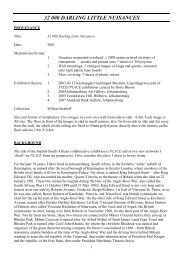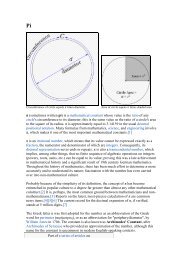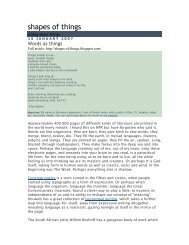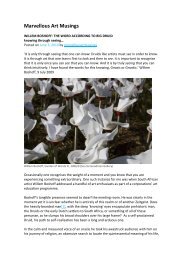Miranthe Staden Garbett Report - Willem Boshoff
Miranthe Staden Garbett Report - Willem Boshoff
Miranthe Staden Garbett Report - Willem Boshoff
Create successful ePaper yourself
Turn your PDF publications into a flip-book with our unique Google optimized e-Paper software.
artifacts and discipline with reference to their ecological, scientific and symbolic significance. In order to<br />
contextualize the worldcentric stage, I will outline the stages of consciousness identified by Wilbur.<br />
Having identified the key traits of a worldcentric consciousness, I will argue that they correspond to<br />
<strong>Boshoff</strong>’s vocabulary and discipline and can be evidenced in his art and commentary (1973-2009).<br />
<strong>Boshoff</strong>’s work has not previously been interpreted according to an integral framework, or described as<br />
worldcentric. Therefore this reading of Children of the Stars is the first analysis of its kind.<br />
Article<br />
The artefacts of <strong>Willem</strong> <strong>Boshoff</strong>’s discipline have always reflected a determined<br />
inclusivity. This is the first indication that his is a worldcentric art, one that resists<br />
homogenizing meta-narratives through an accumulation of multiple perspectives,<br />
languages, histories, processes and media. While this inclusivity is often labelled<br />
postmodernist, <strong>Boshoff</strong>’s art possesses none of the apathy, amorality or irresponsibility<br />
typically associated with postmodernism. His work is not a celebration of chaos, surface,<br />
nihilism or meaninglessness, but a masterful integration of modernist idealism and<br />
rationalism and postmodernist pluralism and doubt. Here, it should be noted that the<br />
shift from modernism to postmodernism corresponds in part to the shift from<br />
ethnocentric to worldcentric consciousness. Interestingly, Integral Theory situates<br />
postmodernism not as an end, but a beginning, a catalyst for more idealistic and<br />
pragmatic cultural trends and ideas such as universal care and welfare,<br />
environmentalism and cultural and religious pluralism (Fernández-Armesto 2003) all of<br />
which point to an emerging worldcentric paradigm. This article examines <strong>Boshoff</strong>’s work<br />
as a harbinger of this emerging consciousness.<br />
Predominantly a conceptual artist, <strong>Willem</strong> <strong>Boshoff</strong>’s art is about communicating ideas.<br />
In addition to having a philosophy, being a worldcentric artist also requires a course of<br />
action, a practice or discipline. For <strong>Boshoff</strong>, who follows in the tradition of Joseph Beuys<br />
and Hans Haacke, an artist has a social responsibility that incorporates pedagogical,<br />
ecological, socio-political and spiritual agendas. His practice as an artist incorporates his








